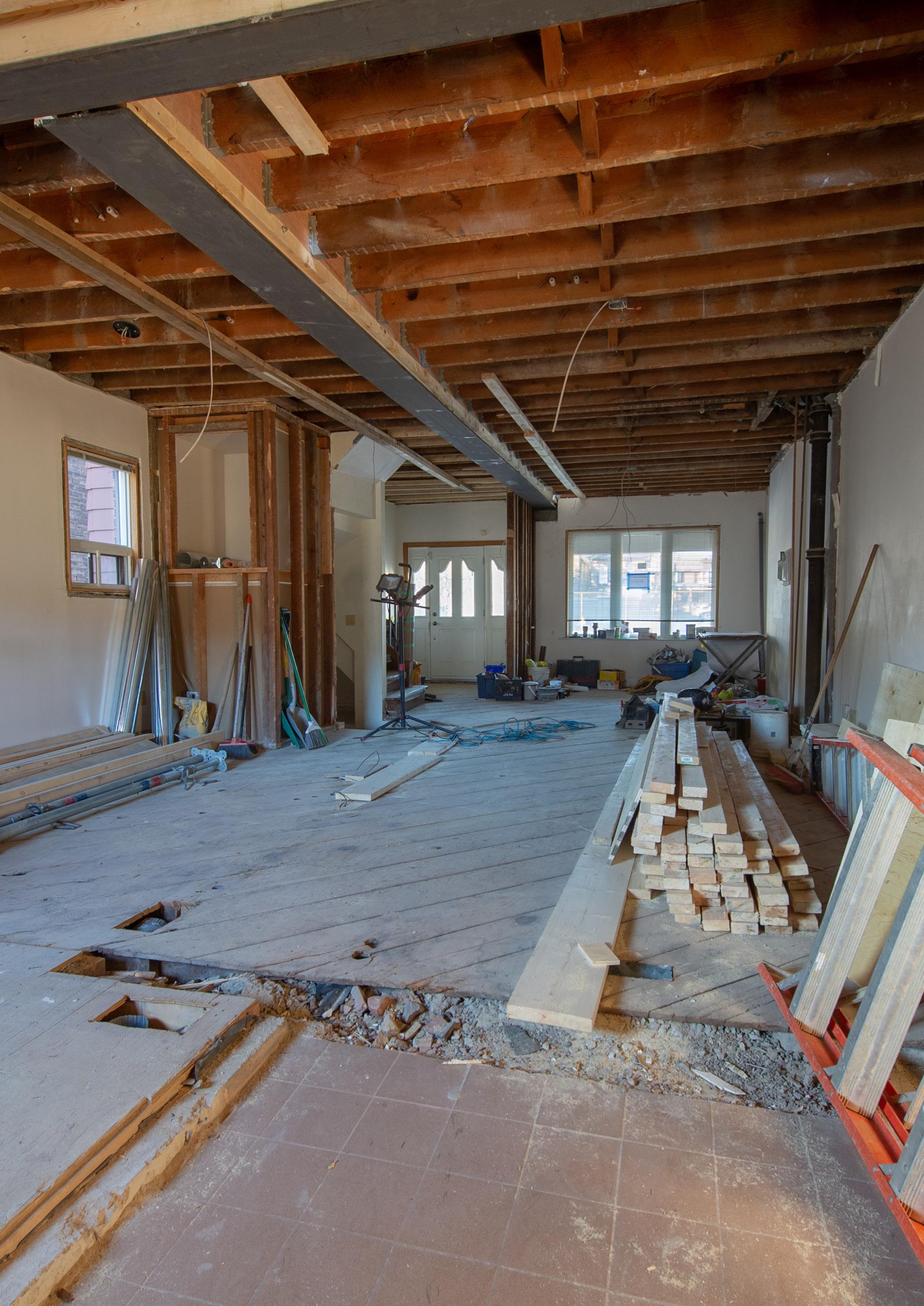Housing Delivery
What’s in the Pipeline for Social Housing in 2023?
Also In This Issue
The Optimised RetroFit Programme: What to Expect in Wales

eMagazine Jan 2023
What's in the Pipeline for Social Housing in 2023?
House Builders must find a way past increasing costs and supply chain issues
As the third wave of the ORP was announced across Wales to help the housing sector achieve a net zero future, Housing Industry Leaders explores the requirements for funding and the potential to revolutionise the housing sector.


In this issue, Housing Industry Leaders analyses how the sector can make the best use of greenfield and brownfield land to ease the housing crisis, how a housing association in Leeds achieved an EPC Rating A, and how Bristol City Leap will transform energy use by 2030.
With a specific focus on how the social housing sector can expand its housing stock faster, Housing Industry Leaders dives into the most topical discussions and debates about the future of the housing industry.
Floyd March
housingindustryleaders.com
f.march@peloton-events.co.uk
P. 2
Contents
P.4
Achieving EPC Rating A: From Dream to Reality for Leeds
P.6
The Optimised RetroFit Programme: What to Expect in Wales
P.8
Achieving a golden thread of information through the DynamicAIM system
P.10
What's in the Pipeline for Social Housing in 2023?
P.12
Brownfield vs Greenfield Land: Why not Develop Both?
P.15
Aico
P.16
Bristol City Leap: Transforming Energy Use by 2030


P.18
CAME Entrotec
P.19
Housing Cymru: Rt Hon Mark Drakeford MS Announced
P.20
Housing Cymru Event Highlight
Multimedia Editor
Floyd March
Multimedia Journalist
Chelsea Bailey
Graphic Designer
Edward Boustred
P. 3
Achieving EPC Rating A: From Prospect to Reality for Leeds
Despite another tough year of missed housebuilding targets and lower than expected retrofit rollout, a Leeds housing estate has set a new exciting benchmark and risen to the top of the UK’s leaderboard in energy efficiency ratings. Delivering a successful retrofit programme with a £9m budget, Holtdale estate in Holt Park, Leeds, is now the toprated area in the UK for energy efficiency. A total of 190 homes were refurbished under the programme, with a whole range of technologies used to reduce carbon emissions and, more importantly for residents, slashed their bills.
Propelling housing stock to EPC Rating A is a new benchmark for the region
Taking a whole-house approach to retrofit is one of the core factors in the success of the program, with other associations and authorities looking to take the framework used and implement it across their housing stock.

The flats that received a whole house retrofit saw the EPC rating skyrocket to Band A, joining a mere 0.2% of homes in England. In a year of unfortunate news in the housing sector, these developments are welcomed by all in the sector.
Saving money is a key selling point for the private sector to retrofit
The project was funded by Leeds City Council, which owns 150 of the flats, and a £4.18m grant from the government’s Social Housing Decarbonisation Fund (SHDF), echoing the importance of public sector funding for the upgrades of homes, especially in the social housing sector.
According to energy and regeneration specialist Equans, residents of the properties can expect their bills to be cut by up to 70% – saving them as much as £1,600 per year. With financial savings the biggest incentive for greener housing stock in the private sector, there are hopes that private landlords and homeowners will see the cost savings and implement a whole house retrofit to their stock and help play their part in meeting ambitious net zero targets.
No one solution for decarbonisation; a whole-house approach is integral
Efficiency measures implemented in Leeds included the installation of new windows, doors and insulation alongside ‘warm roofs’ to keep the homes warmer for longer and reduce the energy needed to heat them.
P. 4
Additionally, the scheme also replaced traditional heating methods with air source heat pumps controlled by smart thermostats. For those living on the top floors of the flats, they received new solar panels to enable residents to generate their own electricity.

James Rogers, Director of Communities, Housing and Environment at Leeds City Council, said: “It is fantastic news that we have completed this project, which supports our ambition to deliver a range of significant environmental improvements for people living in 190 flats on the Holtdale estate.
“This will not only help us reduce carbon emissions and make the 190 homes on the Holtdale estate more energy-efficient, but it will also play a huge role in helping to cut energy costs for people in these homes by up to 70%. We know that, unfortunately, too many people suffer from fuel poverty in Leeds, and it works like this that will help cut those costs and make a real positive impact on people’s lives.”
Steve Batty, Director of Sustainability at Equans, added: “This project has been vital in demonstrating what can be done to decarbonise the UK’s housing stock. It has really led the way when it comes to meeting the government’s goals to upgrade fuel-poor, inefficient homes.
At a time when many are worried about recent energy price hikes, we’re proud to be able to use our expertise to demonstrate how a ‘whole-house’ approach to retrofitting homes can deliver outstanding results.”
Steve Batty Equans
P. 5
The Optimised RetroFit Programme: What to Expect in
Wales
As the Welsh Government looks to help registered social landlords reduce the carbon footprint of existing social housing through the Optimised RetroFit Programme (ORP), questions remain about how impactful the third phase will be.
Optimised RetroFit (ORP) is a whole house, pragmatic, approach to decarbonising existing homes. Offering a more sophisticated insight into the housing sector as a system, this bespoke scheme considers the fabric or materials homes are made from and the way we heat and store energy.
Looking into how energy reaches our homes, the programme is open to Registered Social Landlords and local authorities to install a variety of home decarbonisation measures in the existing social housing stock across Wales.
The third phase of the ORP brings new opportunities for the supply chain
Now in its third phase, the new round of funding is for the financial years 20222025. Focussing on two core objectives, the main themes of the programme are: Affordable Warmth Decarbonisation and understanding the best pathway to better energy efficiency for that home and its residents.
Supporting the Welsh Housing Quality Standard, which at its heart is a tenant focused standard, designed to upgrade social homes in a way that contributes to positive health, education and wellbeing outcomes for tenants, the proposed new standard encourages landlords to consider issues around affordable warmth and decarbonisation across their whole
stock to produce a plan for each home undertaking retrofit.
In a welsh Government statement, Housing Industry Leaders heard: “ORP embraces a test and learn approach to decarbonising homes, adopting a risk appetite which matches the innovative and entrepreneurial activity required to decarbonise effectively and efficiently.”
Focussing on social infrastructure could be the glue for sustainable impacts
Continuing the support for the approach to the decarbonisation of homes, the ORP: “Enables the wider necessary infrastructure to be addressed, ensuring issues such as skills development, procurement, finance models, material selections and the foundational economy are all considered and developed.”
Recipient organisations will be required to complete the proforma and to conform to the outlined format of the proforma.
All recipients to adopt an open book approach to enhance sharing of best practices and lessons learned
Submitted proformas will be considered by the Welsh Government and any areas of clarification will be raised with the recipient organisation.
When the Welsh Government are content that the proforma is completed and meets the requirements set out below, a grant offer letter outlining funding and grant terms and conditions will be sent to the recipient organisation.
Successful projects will be monitored and evaluated, with recipient organisations required to adopt an open book approach as a condition of accepting the funding. For example requests for prime documents such as evidence of defrayment, updated actual
P. 6
ORP e nables the wider necessary infrastructure to be addressed, ensuring issues such as skills development, procurement, finance models, material selections and the foundational economy are all considered and developed.
Welsh Government

P. 7
Achieving a Golden Thread of Information Through the DynamicAIM System
Ahead of the Smart Housing Yorkshire event, Housing Industry Leaders spoke to Ben Kelly, Senior Technical Consultant at Altair, about the partnership between Cadline and themselves, the DynamicAIM system and how technology can get organisations on top of legislative changes.
Cadline and Altair have combined decades of experience and expertise in development, regeneration, asset management compliance and governance regulation in the housing sector with cutting-edge technology solutions.

Industry collaboration in action: Cadline and Altair leading the way
This partnership brings together Cadline’s product and support with Altair’s sector knowledge and technical expertise.
Working across the whole value chain in the housing sector, Altair and Cadline’s services range from development, asset management, regeneration, building safety, compliance and governance.
Producing a ‘golden thread’ of information throughout the value chain, this partnership is uniquely placed to: “Combine expertise and act as one partner that clients can be supported by through the entirety of their journey in producing a golden thread of information,” added Ben.
This support comes through the DynamicAIM product, which is a unique asset information management tool that provides a central cloud-based repository for all necessary building information that allows users to manage existing and new data sources throughout the life cycle of an asset. It incorporates 3D BIM models, drawings, documents and data.
Expanding on this support, Ben explained: “DynamicAIM can help associations and authorities to digitise the data they hold for existing stock, even buildings that have little or no digital or as-built data.”
A golden thread of information allows clients to be proactive
Utilising this technology allows clients to be proactive in identifying key failings and allows action plans to be produced early on in the process. These features permit landlords to better manage their assets in an efficient and effective way which can help them make informed decisions.
P. 8
Ben began to break down the unique benefits of the DynamicAIM system compared to others on the market: “The system interface is easy to use and navigate, which allows users to view detailed 3D BIM models without any requirement for any specialist training or expensive CAD software.”
Another aspect which is unique to this system is the possibility of working alongside existing data management systems. “Linking these systems and databases to pull in necessary information ensures that key information within the DynamicAIM system is up-to-date. This allows for real-time data recording.”
Better quality and management of data is the first step to improving housing stock
As the system gives you a picture of the ‘as-is’ condition, organisations are able to build up action plans to manage their housing stock better. Real-time data allows for a more dynamic and proactive approach to managing housing stock and adapting to legislative changes.
Additionally, the partnership between Cadline and Altair is unlike any other provider. “It is not just a software provider; it comes with sector expertise from Altair and allows clients to draw on both of the respective expertise on offer. Our clients get a better understand of what the sector needs are and what the pressures are, which is coupled with Cadlines software and engineering capabilities to deliver on the issues identified.”
Many software providers don’t have the background experience working within clients’ organisations and often come to clients looking for them to drive the conversation. In contrast, the Cadline and Altair partnership allows them to guide clients along the process and adapt the system in a way to meet their own unique requirements.
When bringing in the DynamicAIM system, Cadline and Altair will work in consultation with clients along the process to ensure they understand the requirements they have to adhere to, which in turn can evolve the
system. “With technology moving fast and the current challenges facing the industry growing, DynamicAIM is agile enough to adapt to these changes,” Ben added.
The requirement for those deemed accountable to hold and maintain a ‘golden thread’ of digital building information, and to produce Building Safety Cases for their buildings, has resulted in the need to manage building information on a scale beyond anything most Registered Housing Providers have seen.
Building Safety Act should be the catalyst for digitalisation
Implementation of the Building Safety Act commences between April and October 2023, with “Accountable Persons” required to begin registering their buildings with the new Regulator during this period.
Wrapping up, Ben explained that:
“DynamicAIM is an essential tool in responding to this new legislative requirement, allowing for the quality of data to be retained and improved over time, enabling better monitoring of in use building performance, compliance and the safety of occupants”
We have always got great awareness of changes in legislative positioning and DynamicAIM as a system is flexible in that individual needs can be met, depending on authority size, housing stock etc.
Ben Kelly
P. 9
Senior Technical Consultant Altair
What's in the Pipeline for Social Housing in 2023?
As the housing sector looks to move on from a turbulent year of housebuilding and retrofit, 2023 offers new hope and fresh ideas for how the UK can upgrade existing housing stock while simultaneously adding to it.
At the back end of 2022, analysis from the BPF showed a 20 per cent year-onyear increase in the total number of Buildto-Rent homes in regional towns and cities as the sector continues to evolve to meet new and growing demands.
Looking at the pipeline trends moving into 2023 is an effective tool for tracking broader progress in the sector, as it perfectly encapsulates long-term growth prospects.
The report highlighted that: “The total number of Build-to-Rent (BTR) homes either in planning, under construction or completed in the UK is up 15% between Q3 2021 and Q3 2022 from 209,313 to 240,202.
The sector is making progress, but a hiatus in 2023 is likely
This offers hope for further progress in the year's initial quarter and beyond, but the impacts of scrapping key housebuilding targets are yet to be seen across the sector. Expanding on the analysis, it was found that: “The BTR pipeline in the regions has also increased by 8% quarter-on-quarter and 22% on an annual basis with 77,282 homes planned.”
Despite the optimism of progression in planning phases, the analysis, conducted at the end of the third quarter in collaboration with Savills, shows there are signs of a slowdown, at least in the short-term, with starts in the first three quarters of 2022 at 10,493, compared to 14,410 at the same point in 2021.
In a statement released by the BPF, Ian Fletcher, Director of Policy, commented: “The Build-to-Rent market had proliferated under an economic backdrop of low-interest rates and low inflation over the last ten years. Current market conditions are clearly very different, but crucially there continues to be demand for high quality professionally managed homes in London and across the regions.”
From the analysis, it is clear that the pipeline of BTR homes would benefit from a more standardised planning approach. Very few local authorities have BTR policies in their local plan, so the application process is often bespoke and takes a long-time. For a sector that is driven by income returns, a long time in planning can hinder progress.
Adding to this, Jacqui Daly, Director of Residential Investment Research at Savills, explained: “The BTR sector has grown strongly, with the pipeline now at over 240,000, but there’s a real need for planning efficiencies and policy support to help maintain the momentum, particularly in major cities where the private rentals market supply issues are most acute.”
The diversification of products to singlefamily residential and into secondary cities highlights how the sector has evolved to date and will continue to do so to cater to needs.
P. 10
Ian Fletcher Director of Policy BPF
A new toolkit from the BPF launched to boost delivery

Following this analysis, the BPF launched a toolkit to boost affordable home delivery available through their website. The reasoning behind the toolkit is to avoid the 95,000 per annum deficit in new affordable homes that the sector faces.




As part of the practical guide to support the increased delivery of affordable homes. This ‘toolkit’ aims to demystify partnership models, learn from those that have taken place, and assist the industry in evaluating effective ways to increase the delivery of much needed affordable housing.
Rob Beiley, Chairman of the British Property Federation’s Affordable Housing Committee and Partner, Trowers & Hamlins, said: “We have launched this toolkit as a practical guide to facilitate effective and long-term partnerships between investors and housing associations. We know that against inflationary pressures and increased investment in existing stock, Housing Associations have to pare back their development programmes.
The toolkit analyses the different structures for partnerships between housing associations and for-profits or investors and identifies several challenges that should be addressed to speed up the creation of partnerships between housing associations and the newer for-profit social housing operators:
1 | Holistic market data around valuations to help partners understand whether disposals/acquisitions are appropriate.
2 | More standardisation of management agreements for the management of social housing by housing associations for forprofits to speed up and simplify the process of putting these agreements in place.

3 | A code of governance for for-profits, along the lines of the existing code for housing associations, to build confidence in for-profit registered providers as partners.
4 | Support for the regulator having more resources to help bulk up their ability to work through new applications and ongoing oversight more fully.
5 | The resolution, or at least clarification, of the different tax and grant treatment faced by housing associations and for-profits.
Brownfield vs Greenfield Land: Why Not Develop Both?

With heated debates surrounding whether to develop on the green belt or brownfield land continuing to grow amongst planners, housebuilders and members of the public, Housing Industry Leaders ask the question: Why not both?

Decreasing the burden on the housing sector is at the forefront of policy decisions coming from the DLUHC. On top of this, think tanks such as the CPS, who released ‘The Case for Housebuilding’ supported by four former housing ministers, indicates the growing frustration in the sector.
Building more stock for private rent, ownership, and social housing is a threepronged approach that would tackle the housing crisis, ease spikes in rent and offer more of an opportunity for first-time buyers to enter the market, all stimulating growth on a regional and national level.
In order to do this, however, vast amounts of land is required to meet these housebuilding targets, something that has been disputed in communities across the UK. On one side of the fence, people believe there is enough brownfield land to fix the housing crisis and secure more housing stock for social housing and private ownership, the other side stipulates this to not be the case and argues the expansion of the greenbelt and building on greenfield land is a better use of space.
P. 12
CPRE recommends utilising brownfield land only
The country side charity CPRE are firmly of the position that brownfield land provides sufficient area to build new homes and tackle the housing crisis. In their recent ‘State of Brownfield 2022’ report, they argued: “Harnessing the potential of brownfield land has multiple benefits if we remove the barriers to its development.”
This annual update from CPRE highlighted the current brownfield land capacity across regions in England and offered recommendations for increased use of our brownfield resource including: “Brownfield land continues to be a perpetually regenerating resource, with the current capacity now standing at 1.2 million new homes (up from 1.1 million in 2021 and 1.05 million in 2018).”
One of the core issues concerning brownfield land development is that a significant amount of land doesn’t have planning permission; this this improved from 2021, to 2022, it was by a

Looking more locally, totals are particularly low within regions needing levelling up, specifically the North West (33%), West Midlands (36%) and Yorkshire & The Humber (40%) regions. Individual local authorities with the highest brownfield capacity in terms of housing plots
Speeding up planning processes could have an increased impact on housebuilding in ‘levelling up hot spots’ but the same is argued about expanding green belts and developing
Continued on page 14

P. 13
The Case for Housebuilding report, written by CPS, a centre-right thinktank, explores the need to build on both brownfield and greenfield land. Raising issues with building solely on brownfield land: “Levels of brownfield land are insufficient. If they could all be built on immediately and at once, they would only provide a land supply for four or so years. There is also strong competition for brownfield land from business and industry.
Reduction in house build completions will impact generations to come
UK housebuilding for both social housing and private ownership has been reducing dramatically, most notedly through the Thatcher and Cameron era of the late 70’s and early 2010’s.
As a share of housing stock, the fall in new supply is even more dramatic – the sector was expanding housing stock by 18% per decade at our peak, but are now doing so by around 8%. This is despite accelerating population growth since the 1990s.
The Case for Housebuilding report stated: “Even if you look at figures for net additional supply, to take account of demolitions and conversions, you find that annual growth in the number of dwellings has roughly halved over the postwar period – again, despite accelerating population growth.”
In addition, the size of new homes has fallen. Post 2005, around 44% of newbuilds have been flats, versus just 18% pre-2005. Post 2005, 54% of homes have one or two bedrooms compared to 37% for older properties. The homes we are building are now the smallest in Europe. Between 1970 and 2021, house prices rose from £4,741 to £267,388. In real terms, that represented a 207% increase. This has been even more pronounced in some regions, particularly in recent years.
The state of the UK housing sector has seen the country freefall down the league tables compared to the rest of Europe. Sitting fourth from bottom among European countries in terms of home ownership rates, it has reversed nearly a century of clear progress toward greater ownership.
Fourth worst home ownership rates in Europe - greenfield allows the UK to climb back
The report argues building on brownfield and greenfield land will allow us to climb further up the leaderboards and offer an opportunity for younger people to get on the property ladder and provide more homes for social rent, reducing long waiting lists putting significant pressure on local authorities.
The rising cost of housing is also shown in rents. Whereas private renters spent 10% of their income on housing from the 1960s to the 1980s, rising to 15% in London, the share of income spent on rent has risen to 30% in recent years, and almost 40% in London.
The report wrapped up by explaining: “In addition, brownfield is not distributed evenly. Only in the North West could it meet 50% of projected need over the next 15 years. Most regions could not even meet 33% of projected need via brownfield.
Much brownfield may be in areas where new homes are unviable, or may require prohibitively expensive remediation. Cities like London and Bristol could build just 24% of the homes they need over the next 15 years on currently existing brownfield sites.
P. 14
, THE CONNECTED HOME LIFE SAFETY SOLUTION
CREATING SMARTER
Aico with HomeLINK offer a network of alarms and sensors to improve the health and safety of homes throughout the UK.
Fire and Carbon Monoxide (CO)
Our 3000 Series offers full circle Fire and CO protection, wirelessly connecting to the SmartLINK Gateway via Radio Frequency for remote wholesystem data monitoring.

SmartLINK Gateway and App

The SmartLINK App enables quick and easy installation of alarms and sensors with SmartLINK technology, while the Gateway is the central hub for data, extracting information from connected devices.
HomeLINK Environmental Sensors



Monitor temperature, humidity and carbon dioxide to gain insights into indoor environmental conditions to create better maintained, healthier, energy efficient homes.


The HomeLINK Portal Data is extracted from all connected alarms and sensors with actionable insights presented on the portal, segmented by high, medium and low risk.

Find out more at: www.aico.co.uk/ smart-home
The HomeLINK App
With the HomeLINK App, residents are provided with a healthy home rating, handy advice on how to improve the quality of their home, and Fire and CO alarm testing reminders.
www.aico.co.uk | 01691 664100 | enquiries@aico.
Bristol City Leap: Transforming Energy Use by 2030
Embarking on a 20 year journey towards transforming the way that Bristol generates, distributes, stores and uses energy, Bristol City Leap sets sail on its new decarbonisation journey with contracts recently signed.
With approval coming just before the 2023 new year, Bristol City Leap was approved by Bristol’s Mayor and Cabinet in December 2022, and contracts to finalise the energy partnership have now been signed by representatives from the organisations that make up the newly established Joint Venture.
Bristol City Council and Ameresco, with Vattenfall as an essential sub-contractor, will be working to decarbonise energy across the whole of the city, with housing at the forefront of innovation. Also present at the signing of the contracts were Councillor Kye Dudd, Bristol’s Cabinet Member for Climate, Ecology, Energy and Waste, Councillor Craig Cheney, Deputy Mayor for Finance, members of the Bristol City Leap team and representatives of Bristol’s One City Environment Board.
Looking to incentivise the market and bring over £1bn of investment to the area, the goal of this partnership is to make Bristol carbon neutral and climate resilient by 2030 by rapidly increasing the scale and pace of investment into low carbon energy infrastructure for the city.
The next five years will have huge impacts on achieving net zero objectives
Over the next five years alone, Bristol City Leap is expected to deliver at least £424 million in a range of large infrastructure projects to reduce Bristol’s carbon footprint by 140,000 tonnes. Projects will include a major expansion of Bristol’s award-winning Heat Network, providing local businesses and residents with access to reliable, fairly priced, low carbon heat from sustainable sources.
Focusing on decarbonisation as a system, Solar panels and low-carbon heating systems will also be installed at local schools, and Bristol City Council’s social housing will be made more energy efficient.
Bristol City Leap will be an initiative with social value at its heart and has the potential to deliver a better quality of life for local residents and is a critical step in our city’s commitment to climate action.
Social value is becoming the backbone of local policy decisions
It is estimated that Bristol City Leap will deliver a minimum of £61.5 million of social value to the city over the next five years including over 1,000 new jobs, apprenticeships and work placements, a new Community Energy Development Fund worth £1.5 million as well as a commitment to Bristol City Leap staff, and any sub-contractors within the supply chain being paid at least the Real Living Wage.
Marvin Rees, Mayor of Bristol said: “Bristol City Leap is a big deal for Bristol. This is a world first and sets out a clear blueprint for city-scale decarbonisation for other cities and regions to follow. Bristol City Leap will have a real impact for Bristol residents including the ways that we power and heat our homes, which is perhaps more important than ever before.
P. 16
Bristol City Leap is expected to install over 182 Mega Watts of low carbon energy generation across Bristol over the first five years of operation whilst enabling additional community-owned renewable energy projects to help residents play a part in Bristol’s journey to carbon neutrality.

Britta MacIntosh, Senior Vice President of Ameresco said: “Our excitement for the potential of Bristol City Leap continues to build as we move past another significant milestone of contract signing. As municipalities across the globe consider next steps in their own decarbonisation path, we hope Bristol City Leap is a showcase example of how action drives transformative results.”
Stuart Allison, Director of Strategy at Vattenfall Heat UK commented: “We are excited to be working with Bristol City Council and Ameresco as part of Bristol City Leap. Bristol City Council have laid strong foundations and we look forward to continuing the work on this forward thinking project that will have such a positive impact on the lives of Bristol residents.
Bristol City Leap has published a summary of its five year business plan covering the range of projects expected to be delivered up until 2027 and will be discussing opportunities across the city through a series of community launch events in March 2023.
With Bristol City Leap, our city will become a real focal point for new low carbon technologies and smart energy systems whilst creating thousands of jobs and ensuring a just transition.
I’m delighted that we have found a partner that shares our vision for a fairer, decarbonised future and it’s great to welcome Ameresco and their partner Vattenfall to Bristol today.
P. 17
Marvin Rees Mayor of Bristol
door
industry leading access systems


Complete cloud solutions that simplify access control and site management for all users.
Project development support
Free project assistance, from system design to contractor support during installation.
system Bespoking
Tailored system design to deliver client led quality access control solutions

Expert technical support
Our UK based technical team are readily available to offer remote support.

Manufacturer Diagnostic visits
Mobile service teams available to visit site and ensure system reliabilty is optimised.
do you want to work with the leading access control provider in the industry?
We want to work with you. Our experience is vast, our products are quality and our service is second to none. See for yourself. Work with us on your next project.
Call: 01506 886230 Email: saleshq@entrotec.co.uk
came.com/entrotec

came.com/kms


saving you time without compromising security & reliability P. 18
entry & access control solutions
Cymru
Mercure Holland House Hotel, Cardiff
11 July 2023
KEYNOTE SPEAKER
Rt Hon Mark Drakeford MS


First Minister of Wales
Building on the initial phases of the Optimised RetroFit Programme (ORP), this one day conference will explore how a whole house, pragmatic approach to decarbonising existing homes is essential across Wales.

Setting out core objectives of the ORP, Rt Hon Mark Drakeford MS will explore the core themes of the programme, including affordable warmth decarbonisation goals and understanding the best pathway to better energy efficiency for social homes and their residents.
The day will consist of a series of keynote speeches, panel discussions and technical seminars, with an exhibition zone running throughout the day.
#HousingCymru
#HousingLeaders
housingindustryleaders.com
P. 19
Covering all Angles of the Housing Industry
11 July 2023
Mercure Holland House Hotel, Cardiff
Why Housing Industry Leaders?
Setting out core objectives of the ORP, Rt Hon Mark Drakeford MS will explore the core themes of the programme, including affordable warmth decarbonisation goals and understanding the best pathway to better energy efficiency for social homes and their residents.
The day will consist of a series of keynote speeches, panel discussions and technical seminars, with an exhibition zone running throughout the day.

Join us on 11 July 2023 at Mercure Holland House Hotel, Wales, where housing leaders, experts and innovators will be discussing what is needed right now to drive meaningful change and create communities for the future.
Join the conversation #HousingLeaders










































